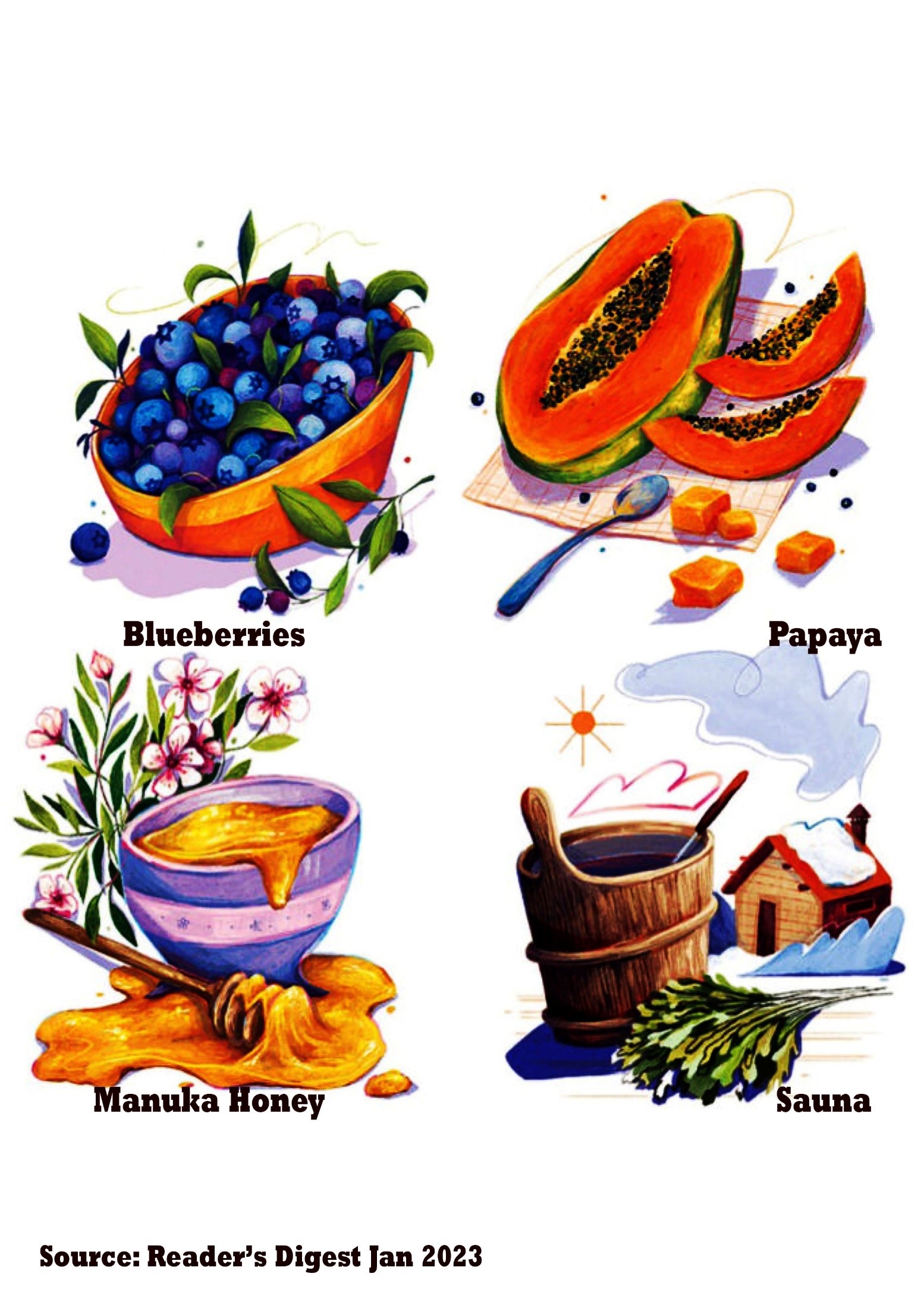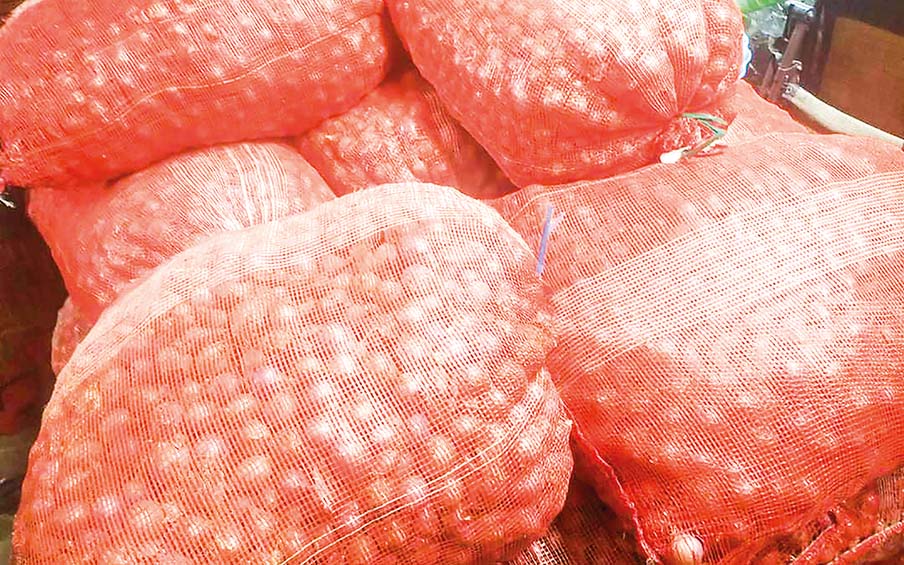By Yin Nwe Ko
We have been getting used to consuming folk remedies anyway in our lives for ages. In fact, A folk remedy is a traditional medicine not prescribed by a doctor. Many educated people often look down upon it because they think it is not scientifically produced and its purity is not flawless. However, there have been many pieces of evidence that folk remedies saved many people’s lives and cured many ailments or wounds. The following article is a collection of well-known remedies around the world recommended by the members of the editorial team of Reader’s Digest Magazine around the world.
Many of us use home treatments — some passed down through generations — for small ailments, whether the treatment has officially been proven to be effective or not. Editors at Reader’s Digest editions around the world are no different — except we have investigated our favourites to make sure they are backed by solid research. Here are several folk remedies that work for us.
Wild Blueberries (Improve Heart Health)
Blueberries— both cultivated and wild—are Canada’s top fruit export. Wild blueberries can be found in several Canadian provinces but are especially abundant in Quebec and Atlantic Canada. Widely known as a super-fruit, wild blueberries in particular are loaded with healthful antioxidants — containing nearly twice the amount that the same serving size of cultivated blueberries does. And while slightly smaller in size than cultivated ones, wild blueberries are generally sweeter and more flavorful.
Blueberries get their colour from anthocyanins, a group of antioxidant compounds that are responsible for many health benefits. Most of the colour, and therefore the fruit’s benefits, are found in its skin. Whether cultivated or wild, all blueberries have anti-inflammatory and anti-cancer properties, but it’s their cardiovascular benefits that really stand out. Multiple studies have found eating at least a cup of blueberries a day offers significant improvements in vascular function and arterial stiffness, with one 2019 study from researchers in the United Kingdom and the United States showing that blueberries could cut the risk of cardiovascular disease by as much as 15 per cent.
If fresh wild blueberries are not readily available where you live, frozen wild blueberries are a great alternative. One small study suggests freezing actually improves blueberries’ antioxidant availability.
Vinegar (Fights Infection)
French folklore has it that during the bubonic plague in the 17th century, a gang of four thieves robbed corpses but never caught the disease themselves. Supposedly, anointing their bodies with a concoction of vinegar and herbs protected them.
The so-called vinaigre des quatre voleurs (four thieves’ vinegar) is used today in France in the belief that it fights infection. Many of the ingredients steeped in vinegar — garlic, rosemary, sage, lavender, thyme, juniper berry, black pepper, and more—have proven antibacterial properties.
“I know people who consume this regularly as an antibacterial,” says Stéphane Calmeyn, Paris-based editor of Reader’s Digest. He adds that a friend of his with type 2 diabetes credits the vinegar with helping regulate his blood sugar.
Though more research is needed, there is evidence that vinegar, particularly the kind made from apple cider, can affect blood sugar levels by delaying the rate at which the stomach empties and starch is digested, which reduces blood sugar spikes after a meal. But check with your doctor before adding it to your diet, particularly if you are taking medications to lower your blood sugar.
Apple cider vinegar may also prevent overeating. A small Swedish study found that people who consumed vinegar with a meal reported feeling more satiated than those who did not, which could prevent unhealthy snacking later in the day.
Keep in mind that it is best not to drink vinegar undiluted, as its acidity could damage tooth enamel. Instead, add one or two teaspoons of water or tea.
Liquorice (Relieves Sore Throat)
Liquorice-based candies, called dropjes, are as Dutch as wooden shoes — but while few farmers still wear wooden shoes, everybody eats dropjes. “It’s a sort of national pride,” says Amsterdam-based Reader’s Digest editor Paul Robert.
Besides being somewhat of an addiction for the Dutch, it is widely known in northern European countries that liquorice serves a medicinal purpose: sore-throat relief. Indeed, a 2013 randomized, double-blind study of 236 people by the Medical University of Vienna found that patients who gargled a liquorice solution before going into surgery requiring throat intubation had a lower likelihood of sore throat after the operation.
There is also evidence that glycyrrhizin, a liquorice-derived compound, has anti-inflammatory and anticancer properties. According to a 2022 review published in Pharmacological Research, it is a promising area of cancer research.
Still, experts caution against consuming more than 100 milligrams of glycyrrhizin per day, as it can dangerously reduce blood potassium levels. (A cup of liquorice tea contains roughly 30 milligrams, according to The British Medical Journal.)
“When I was a child, the best thing about having a cold was that I’d get lots of dropjes,” says Robert. “Sucking on them soothed my throat back then, and still does now.” Dropjes range from very sweet to very salty, and the salty ones are an acquired taste.
Calendula (Calms Inflammation)
“Many people in Germany consider calendula a miracle cure, and have their own recipe for a balm,” says Annemarie Schäfer, who works on the Reader’s Digest team in Stuttgart.
Her cousin Marlen, a teacher, recalls that when her mother grew calendula — also called marigolds—in her garden, she would dry their orange and yellow heads and mix them with warm pork fat (you can also use petroleum jelly, beeswax, or olive oil). After a day of steeping, the mixture was strained and jarred, to be used on rough hands, insect bites, acne, and other skin irritations.
The high levels of antioxidants in the dried petals are beneficial. Laboratory and animal research has shown that flowers contain anti-inflammatory and antimicrobial components that prevent infection and heal wounds by helping new blood vessels and tissue formation. In patients with venous leg ulcers treated with either calendula ointment or saline-solution dressings, calendula helped ulcers heal much faster.
With these benefits in mind, it’s no wonder cosmetic companies are also turning to calendula — specifically, calendula flower extract — to formulate soothing products geared to sensitive skin. According to a 2021 study from the University of Porto in Portugal, the plant’s anti-inflammatory properties are helpful in treating irritated skin as well as allergic contact dermatitis, rosacea, and psoriasis.
Papaya (Aids Digestive Health)
A study from Obafemi Awolowo University in Nigeria published in the Journal of Medicinal Food found that papaya fights intestinal parasites. When researchers gave a papaya seed preparation to children who tested positive for intestinal parasites, it was shown to be anthelminthic (capable of eliminating parasitic worms) and anti-amoebic (capable of destroying or suppressing amoebas). It treated their parasites without harmful side effects.
Results of a double-blind, placebo-controlled trial that was published in the journal Neuroendocrinology Letters in 2013 showed that volunteers with digestive complaints like bloating and constipation had significant improvements after ingesting a papaya pulp supplement. Papaya is also rich in vitamin C, and high in water and fibre content, all of which regulate bowel activity. It is consumed abundantly in Costa Rica.
St. John’s Wort (Soothes Skin)
Many people around the world use a balm containing St. John’s wort to promote wound healing and soothe skin — for example, in cases of sunburn and insect bites. St. John’s wort is a plant with yellow flowers that’s native to Europe, northern Africa, and southwestern Asia.
Animal studies conducted in Turkey in the past few years have shown that St. John’s wort helps to promote wound healing and relieves burns; rats treated topically with St. John’s wort four times a day experienced more rapid healing than those in the other groups.
And 2010 Iranian randomized, double-blind clinical trial of 144 women published in the Journal of Alternative and Complementary Medicine showed that women who had undergone Caesarean sections and applied a St. John’s wort ointment three times a day for 16 days had improved wound healing and less pain and scarring than those in the placebo and control groups.
Ingesting St. John’s wort may also treat mild to moderate depression, and menopause symptoms such as hot flashes. But speak to your doctor before taking it, because it can cause serious side effects and drug interactions. It is also used in Africa, Asia, and Europe.
Garlic (Gets Rid of Warts, Corns, and Calluses)
Corns and calluses both involve a buildup of skin at pressure points on the foot, while warts are small growths that can occur anywhere on the body and are caused by the human papillomavirus, or HPV. Research from 2005 published in the International Journal of Dermatology showed that warts treated daily with a garlic extract disappeared for study subjects within two weeks, and corns vanished for 80 per cent of subjects after three weeks.
Garlic has antibacterial properties (thanks to its main component, allicin), and its antiviral effect may attack the virus that causes warts. Just be careful not to allow raw garlic to touch healthy skin, as it can cause irritation and damage similar to a burn.
It worked for a Reader’s Digest reader named Georgina, of central Portugal. “A few years ago, when my friend’s aunt noticed me limping because of a callus, she told me about this home remedy. I baked a few garlic cloves, crushed them, and applied the pulp to the callus, avoiding healthy skin. I covered it with gauze and changed this compress daily. Although the smell was a little intense, my callus disappeared after five days.”
Eucalyptus Oil (Clears Sinuses)
Eucalyptus oil can help alleviate cold symptoms like nasal congestion by clearing the airways. In a randomized, double-blind trial of 152 people, published in The Laryngoscope in 2009, German researchers found that the main component of eucalyptus oil — 1,8-cineole, or eucalyptol — was effective and safe for treating sinusitis, because it helped to clear nasal blockages and mucus.
The eucalyptus tree is native to Australia, and the oil from its leaves is similarly beneficial if you have perennial allergic rhinitis — a chronically stuffy or runny nose due to pet dander, mould, or dust.
A South Korean study, published in 2016 in Evidence-Based Complementary and Alternative Medicine, found that essential oils including eucalyptol alleviated those symptoms. Out of 54 people aged 20 to 60, those who inhaled the aromas for five minutes twice daily over seven days also had better sleep compared with those who inhaled a placebo.
Add a few drops to a bowl of steaming water, hover your face over the bowl and cover your head with a towel. Breathe in. Note: don’t ingest eucalyptus oil, and avoid applying it directly to your skin; if it’s undiluted it could cause irritation.
Manuka Honey (Helps Many Ailments)
For centuries the Maori people of New Zealand have relied on the bark and leaves of the manuka bush — native to the island nation and sometimes called a tea tree — for its health-giving properties. More recently, the honey made from its white or pink flowers has become the star: research, including a 2018 study from the UK, shows this type of honey has much higher levels of anti-bacterial and wound-healing compounds than others. It has anti-mutagenic (decreasing or preventing genetic mutation), antioxidant and anti-inflammatory qualities.
Research from Cardiff University showed that components of manuka honey can stimulate immune cells, therefore increasing our ability to fight bacteria. (It’s especially effective against a strain of streptococcus.)
Recently, scientists at Aston University in Birmingham, England, combined manuka honey with the antibiotic amikacin to develop a potential new treatment for a lung infection caused by the bacteria Mycobacterium abscessus. By combining manuka honey with an existing therapy, researchers believe they have found a way to kill off the bacteria with less of the drug and, as a result, fewer side effects.
Arnica (Reduces Bruising)
Arnica is popular in Mexico, says Reader’s Digest editor Luis Eduardo Pineda in Mexico City. “I played basketball when I was a kid, and sometimes my fingers would get painfully bruised. My mother would rub them with arnica balm, and in a few days the bruising would be gone.” These days, he uses it for sore muscles. “I keep arnica balm in my first aid kit.”
Anti-inflammatory arnica, a herb from the same family as asters and daisies, is said to reduce swelling and bruising. A 2013 review of 174 people with hand arthritis found that arnica gel reduced pain and improved function in the hand as effectively ibuprofen gel. Since arnica can be poisonous, it should not be taken orally.
Aloe Vera (Relieves Burns)
Pineda has another go-to remedy: aloe vera or sábila. A review of four studies from Asia, published in the journal Burns, concluded that aloe mucilage (the gelatinous substance inside its leaves) and some aloe products can accelerate the healing of minor burns several days faster than conventional medication. “Recently, I grabbed the handle of a hot pan,” recalls Pineda. “But I have an aloe vera plant, so I got relief quickly.”
Cranberries (Prevent urinary tract infections)
Originally consumed by Indigenous peoples to treat bladder and kidney diseases, cranberries were later used by early settlers to North America for a variety of conditions, including appetite loss, stomach problems, blood disorders, and scurvy. Their most popular use, however, has been for the prevention and treatment of urinary tract infections (UTIs), although research has been mixed on the effectiveness of cranberry for this purpose.
Initially thought to work by making urine acidic enough to kill E. coli, which is the type of bacteria that commonly causes UTIs, cranberry is now more widely accepted as a way to prevent UTIs rather than to treat them. That’s because researchers believe a compound found in cranberries helps prevent E. coli-causing bacteria from adhering to the cells that line the urinary tract.
In a 2019 study published in the Journal of Natural Products, researchers identified cranberry oligosaccharide, a complex carbohydrate, in the urine of female pigs who were fed dried cranberry powder. Further research is needed, but scientists are closer to understanding how cranberry consumption prevents bacterial adherence to the urinary tract, and these oligosaccharides are thought to play a significant role. It is being still used in The United States at the moment.
Sauna (Boosts Circulation)
“The steam sauna has been a Finnish tradition for hundreds of years and most Finns go regularly,” says Ilkka Virtanen, the Helsinki-based editor of Reader’s Digest. “It’s good for heart health.”
A sauna is typically a room heated up to 90 C. When a person sits sweating in one, their heart rate increases, as does blood flow in the skin, boosting circulation as much as low to moderate exercise does. According to a 2015 study of Finnish men published in the journal JAMA Internal Medicine, the risk of heart attack and stroke is reduced. (That research also showed that sitting in a sauna two to three times a week lowers the risk of dying from any cause by 24 per cent.)
Regular sauna sessions not only lower cardiovascular disease risk, but they may also benefit adults with existing heart disease. A 2021 study published in the Canadian Journal of Cardiology found that a typical Finnish sauna session — about 10 minutes — acutely improved blood vessel health and reduced blood pressure in adults with stable coronary artery disease.
Another study showed that 15 minutes a day in a sauna, five days a week, may help ease mild depression. If you’re new to the sauna, start with five or 10 minutes, gradually increasing, if you wish, to 20 minutes. Drink plenty of water and avoid alcohol; it causes further dehydration. And if you have heart disease or blood pressure issues speak to your doctor first about whether a sauna is safe for you.
In sum, although folk remedies are not prescribed by doctors, most of us actually know that they are effective in curing some particular ailments. Moreover, they are abundantly found in nature, and we are given them as a present by nature. Therefore, we should thank nature, shouldn’t we?
Reference: Reader’s Digest Jan 2023















